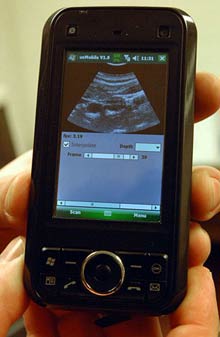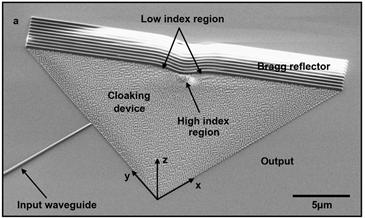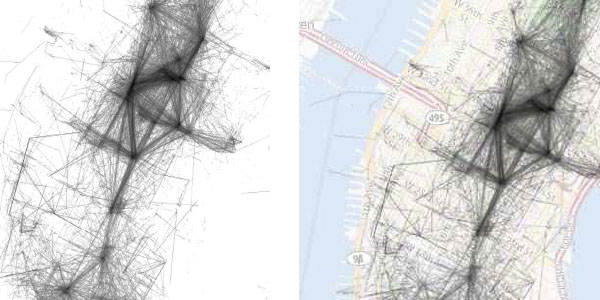 |
Mobile medicine: The ultrasound image shown here was captured using only a portable probe and the smart phone itself.
Credit: David Kilper/WUSTL Photo |
In a twist of engineering that could redefine mobile medicine, researchers have built an ultrasound device that can be plugged directly into a smart phone's USB port. The system can capture ultrasound images of pregnant bellies and blocked carotid arteries, display them immediately on-screen, and even use the phone's capabilities to send that data just about anywhere in the world.
Physicians rely on ultrasound imaging for everything from monitoring fetal and cardiac health to providing guidance when placing catheters and central lines. Most of the time, however, the systems are large and cumbersome--handheld probes attached to wheeled computers the size of filing cabinets. They're also quite pricey: the larger, more versatile systems can cost $25,000 or more. Self-contained pocket-sized systems do exist but cost about $10,000. Nothing available today provides a low-cost, mobile solution that can be used remotely to both gather and transmit images.
The compact ultrasound probe, developed by computer engineers at Washington University, in St. Louis, has the potential to do all of that and more. Prompted by a grant program at Microsoft that called for the design of smart-phone-enabled medical devices, William Richard and David Zar started with an instrument that they developed five years ago: a $2,000 ultrasound probe that can plug into a laptop's USB port. Richard transferred all of the computing power into the probe itself and decreased its power draw to just half a watt; Zar created the necessary software and drivers.
To squeeze such capabilities into the probe, Richard and Zar had to make some concessions. In order to decrease its power requirements, Richard had to also decrease the amount of data that the instrument transmitted. The images themselves are smaller and less detailed than those from a full-size ultrasound. But while it has yet to undergo rigorous testing and comparisons, the researchers believe that its capabilities should be more than sufficient for many medical applications. They point to a number of potential uses: remote medicine for rural communities and developing nations, emergency imaging of patients en route to the hospital, battlefield medicine, and even home use in patients with chronic diseases. "Looking back on this 10 years from now," Richard says, "these are going to be used in places we never would have imagined."
The most obvious and immediate use is providing care for people in underserved communities, both in the United States and abroad. Even in some of the poorest nations, cell-phone networks are fairly ubiquitous and could be used to immediately send images taken by the probe to a trained medic for interpretation.
Gari Clifford, a computational physiologist at the Harvard-MIT Division of Health Sciences and Technology, is interested in incorporating the new ultrasound probe into a remote medicine system that he's developing. By prescreening pregnant women in remote areas for dangerous complications, "we can advise them to go into a more urban and centralized clinic to give birth," he says. "Many rural clinics in developing countries really don't have the expertise or technology to do this kind of screening."
Shadab Mahmud, a program manager at Grameen Healthcare, offers a similar vision. The nonprofit, which is part of the same group of enterprises as the Nobel-winning Grameen Bank, was recently launched to provide sustainable health care in Bangladesh. "In developing countries, about 95 percent of the births occur at home, and that's where most of the deaths occur as well," Mahmud says. "The ultrasound probe is an integral part of a kit that each and every community health worker would have."
A number of groups have already expressed interest in the device. According to Zar, for the same $2,000 that buys the laptop-based probe he helped develop, the manufacturer can build the smart-phone version, and he aims to have open-source software available this summer. (The user must also have a compatible phone; currently, only a few have the necessary capabilities, such as a USB port that can read input and provide power.) Richard is already looking further ahead: his goal now is to create a $199 version that could one day be sold in drugstores for home use.
Copyright Technology Review 2009.




 In another targeted shot at Twitter, Facebook is expected to announce on Monday that developers can take the streams of Facebook status updates on user profiles and mix them into new applications. Just like the
In another targeted shot at Twitter, Facebook is expected to announce on Monday that developers can take the streams of Facebook status updates on user profiles and mix them into new applications. Just like the 
